Analysis and Implementation of a Lead Learning Strategy in Management
VerifiedAdded on 2023/01/20
|11
|2376
|30
Report
AI Summary
This report provides a comprehensive analysis of lead learning strategy implementation within a management context. It begins by exploring e-learning compliance systems and their role in skill and knowledge acquisition, highlighting systems like Docebo and Adobe Captivate Prime. The report then delves into the requirements for Registered Training Organizations (RTOs) and their compliance obligations, including adherence to the VET Quality Frameworks and relevant legislation. It identifies codes of practice, legislation, and national standards associated with leading strategy management implementation. The report also examines organizational learning theories, including single and double-loop learning, and discusses various organizational evaluation strategies such as the Theory of Change and Logic Model. Furthermore, it explores the concept of continuous improvement (CI) and its significance in organizational management, outlining steps for successful implementation and the impact on stakeholders. The report details the steps involved in implementing organizational learning strategies, emphasizing the importance of management support, employee involvement, and effective communication. It also covers consultation and communication processes, key stakeholders, and techniques for communicating with customers. The report concludes with contemporary approaches for assessing instruments and strategy design, along with the necessary resources for implementing marketing activities and complying with quality management standards.
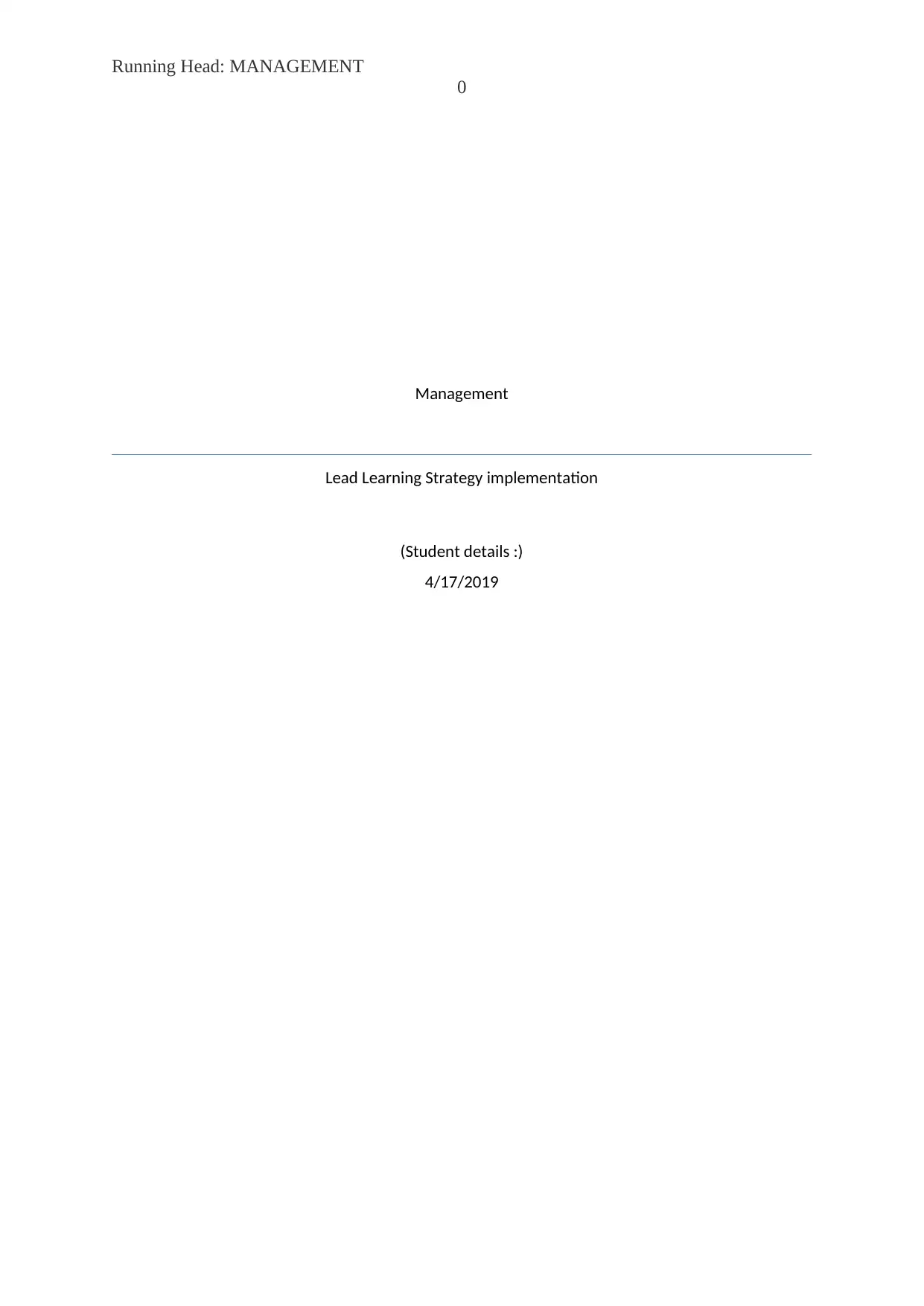
Running Head: MANAGEMENT
0
Management
Lead Learning Strategy implementation
(Student details :)
4/17/2019
0
Management
Lead Learning Strategy implementation
(Student details :)
4/17/2019
Paraphrase This Document
Need a fresh take? Get an instant paraphrase of this document with our AI Paraphraser

Management
1
Lead Learning Strategy implementation
Solution 1
In this era, e-Learning compliance systems have revolutionized as well as changed the way in
which we look at skill and knowledge acquisition. Therefore, demand for Learning
Management Systems (e-LMS) has been increased for systematically implementing and
managing the eLearning all across the globe. In this context, five international e-learning
compliance systems are as follows:
1. Docebo is a cloud based e-Learning management system, which is highly acclaiming
LMS worldwide. Docebo is endorsed through reputable companies like Bloomberg,
Thomson Reuters and Sharp.
2. Adobe Captivate Prime (ACP) has full control on the eLearning courses’ setup,
delivery as well as learner growth along with functional features.
3. Litmos LMS is famous international learning tool famous for training purposes.
4. iSpring Learn is also for employees training
5. Talent LMS is an effective e-learning system used by the whole world (Putnam &
Nicotera, 2009).
Solution 2 (a)
For all Registered Training Organizations (RTOs), they should consider register with ASQA
from the perspective of authority compliance needs and obligations. Hence, RTOs must be
equipped and prepared for meeting the below listed requirements to be a RTO:
They should compliance with components of the Vocational Education and Training
(referred as VET) Quality Frameworks (ASQA, 2019).
They should cooperate with ASQA comprising compliance with all general
directions as well as cooperation related to compliance monitoring activities.
1
Lead Learning Strategy implementation
Solution 1
In this era, e-Learning compliance systems have revolutionized as well as changed the way in
which we look at skill and knowledge acquisition. Therefore, demand for Learning
Management Systems (e-LMS) has been increased for systematically implementing and
managing the eLearning all across the globe. In this context, five international e-learning
compliance systems are as follows:
1. Docebo is a cloud based e-Learning management system, which is highly acclaiming
LMS worldwide. Docebo is endorsed through reputable companies like Bloomberg,
Thomson Reuters and Sharp.
2. Adobe Captivate Prime (ACP) has full control on the eLearning courses’ setup,
delivery as well as learner growth along with functional features.
3. Litmos LMS is famous international learning tool famous for training purposes.
4. iSpring Learn is also for employees training
5. Talent LMS is an effective e-learning system used by the whole world (Putnam &
Nicotera, 2009).
Solution 2 (a)
For all Registered Training Organizations (RTOs), they should consider register with ASQA
from the perspective of authority compliance needs and obligations. Hence, RTOs must be
equipped and prepared for meeting the below listed requirements to be a RTO:
They should compliance with components of the Vocational Education and Training
(referred as VET) Quality Frameworks (ASQA, 2019).
They should cooperate with ASQA comprising compliance with all general
directions as well as cooperation related to compliance monitoring activities.
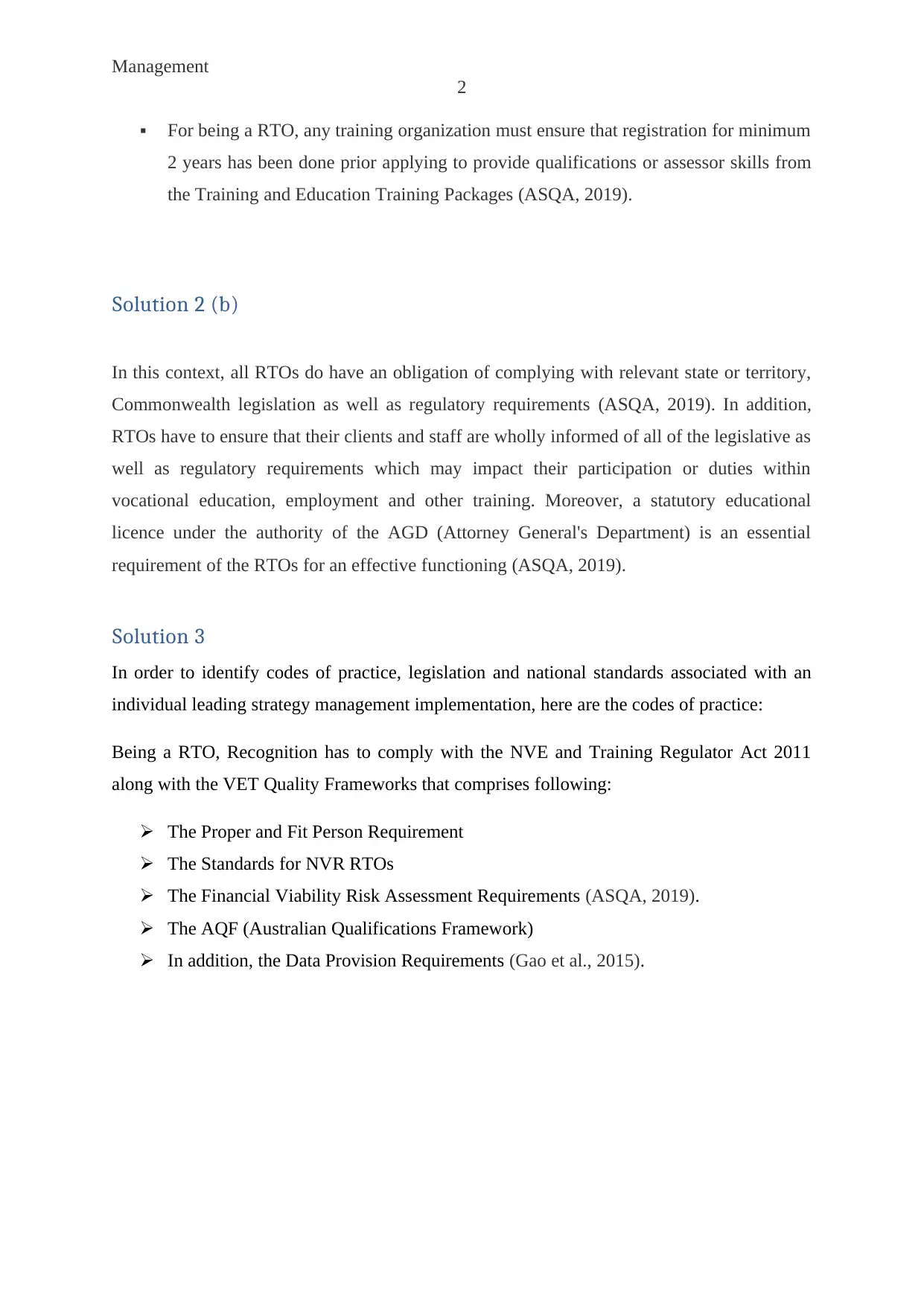
Management
2
For being a RTO, any training organization must ensure that registration for minimum
2 years has been done prior applying to provide qualifications or assessor skills from
the Training and Education Training Packages (ASQA, 2019).
Solution 2 (b)
In this context, all RTOs do have an obligation of complying with relevant state or territory,
Commonwealth legislation as well as regulatory requirements (ASQA, 2019). In addition,
RTOs have to ensure that their clients and staff are wholly informed of all of the legislative as
well as regulatory requirements which may impact their participation or duties within
vocational education, employment and other training. Moreover, a statutory educational
licence under the authority of the AGD (Attorney General's Department) is an essential
requirement of the RTOs for an effective functioning (ASQA, 2019).
Solution 3
In order to identify codes of practice, legislation and national standards associated with an
individual leading strategy management implementation, here are the codes of practice:
Being a RTO, Recognition has to comply with the NVE and Training Regulator Act 2011
along with the VET Quality Frameworks that comprises following:
The Proper and Fit Person Requirement
The Standards for NVR RTOs
The Financial Viability Risk Assessment Requirements (ASQA, 2019).
The AQF (Australian Qualifications Framework)
In addition, the Data Provision Requirements (Gao et al., 2015).
2
For being a RTO, any training organization must ensure that registration for minimum
2 years has been done prior applying to provide qualifications or assessor skills from
the Training and Education Training Packages (ASQA, 2019).
Solution 2 (b)
In this context, all RTOs do have an obligation of complying with relevant state or territory,
Commonwealth legislation as well as regulatory requirements (ASQA, 2019). In addition,
RTOs have to ensure that their clients and staff are wholly informed of all of the legislative as
well as regulatory requirements which may impact their participation or duties within
vocational education, employment and other training. Moreover, a statutory educational
licence under the authority of the AGD (Attorney General's Department) is an essential
requirement of the RTOs for an effective functioning (ASQA, 2019).
Solution 3
In order to identify codes of practice, legislation and national standards associated with an
individual leading strategy management implementation, here are the codes of practice:
Being a RTO, Recognition has to comply with the NVE and Training Regulator Act 2011
along with the VET Quality Frameworks that comprises following:
The Proper and Fit Person Requirement
The Standards for NVR RTOs
The Financial Viability Risk Assessment Requirements (ASQA, 2019).
The AQF (Australian Qualifications Framework)
In addition, the Data Provision Requirements (Gao et al., 2015).
⊘ This is a preview!⊘
Do you want full access?
Subscribe today to unlock all pages.

Trusted by 1+ million students worldwide

Management
3
Source: (Gao et al., 2015)
Solution 5
Organizational learning and evaluation is a diverse and expansive field with considerable
effects which can be seen through psychology, sociology, philosophy, business management,
many more. The organizational learning theories are commonly explained as a procedure of
forming, retaining, as well as transferring knowledge in an organization (Sherman, 2018). In
this way, carrying this perspective, organizational learning occurs as a result of experiences
because an organization is supposed to have knowledgeable through an experience while
there is a major variation with in the organization's performance.
Source: (Jones, 2013)
In this way, two organization behavioural theories are as follows:
3
Source: (Gao et al., 2015)
Solution 5
Organizational learning and evaluation is a diverse and expansive field with considerable
effects which can be seen through psychology, sociology, philosophy, business management,
many more. The organizational learning theories are commonly explained as a procedure of
forming, retaining, as well as transferring knowledge in an organization (Sherman, 2018). In
this way, carrying this perspective, organizational learning occurs as a result of experiences
because an organization is supposed to have knowledgeable through an experience while
there is a major variation with in the organization's performance.
Source: (Jones, 2013)
In this way, two organization behavioural theories are as follows:
Paraphrase This Document
Need a fresh take? Get an instant paraphrase of this document with our AI Paraphraser
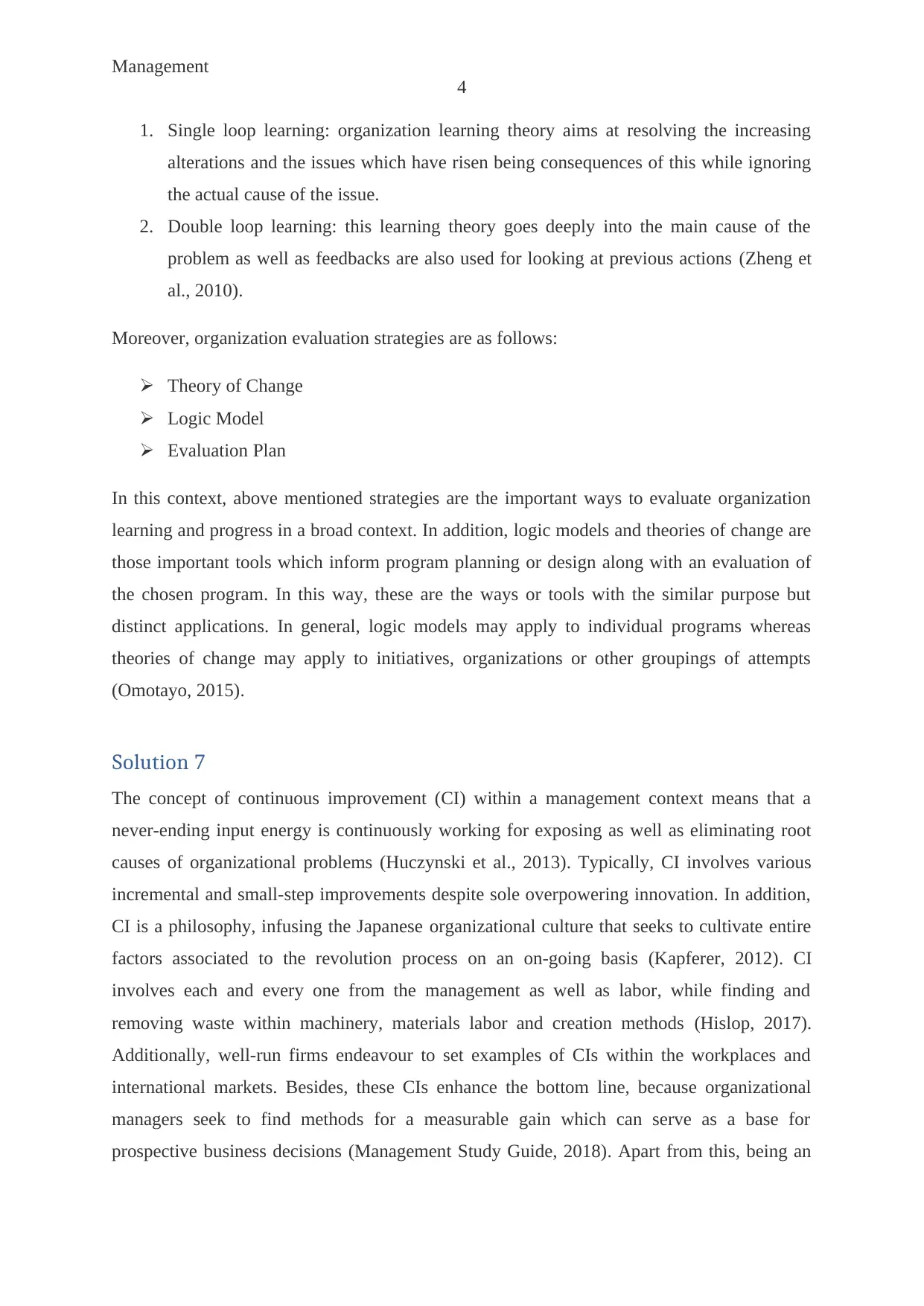
Management
4
1. Single loop learning: organization learning theory aims at resolving the increasing
alterations and the issues which have risen being consequences of this while ignoring
the actual cause of the issue.
2. Double loop learning: this learning theory goes deeply into the main cause of the
problem as well as feedbacks are also used for looking at previous actions (Zheng et
al., 2010).
Moreover, organization evaluation strategies are as follows:
Theory of Change
Logic Model
Evaluation Plan
In this context, above mentioned strategies are the important ways to evaluate organization
learning and progress in a broad context. In addition, logic models and theories of change are
those important tools which inform program planning or design along with an evaluation of
the chosen program. In this way, these are the ways or tools with the similar purpose but
distinct applications. In general, logic models may apply to individual programs whereas
theories of change may apply to initiatives, organizations or other groupings of attempts
(Omotayo, 2015).
Solution 7
The concept of continuous improvement (CI) within a management context means that a
never-ending input energy is continuously working for exposing as well as eliminating root
causes of organizational problems (Huczynski et al., 2013). Typically, CI involves various
incremental and small-step improvements despite sole overpowering innovation. In addition,
CI is a philosophy, infusing the Japanese organizational culture that seeks to cultivate entire
factors associated to the revolution process on an on-going basis (Kapferer, 2012). CI
involves each and every one from the management as well as labor, while finding and
removing waste within machinery, materials labor and creation methods (Hislop, 2017).
Additionally, well-run firms endeavour to set examples of CIs within the workplaces and
international markets. Besides, these CIs enhance the bottom line, because organizational
managers seek to find methods for a measurable gain which can serve as a base for
prospective business decisions (Management Study Guide, 2018). Apart from this, being an
4
1. Single loop learning: organization learning theory aims at resolving the increasing
alterations and the issues which have risen being consequences of this while ignoring
the actual cause of the issue.
2. Double loop learning: this learning theory goes deeply into the main cause of the
problem as well as feedbacks are also used for looking at previous actions (Zheng et
al., 2010).
Moreover, organization evaluation strategies are as follows:
Theory of Change
Logic Model
Evaluation Plan
In this context, above mentioned strategies are the important ways to evaluate organization
learning and progress in a broad context. In addition, logic models and theories of change are
those important tools which inform program planning or design along with an evaluation of
the chosen program. In this way, these are the ways or tools with the similar purpose but
distinct applications. In general, logic models may apply to individual programs whereas
theories of change may apply to initiatives, organizations or other groupings of attempts
(Omotayo, 2015).
Solution 7
The concept of continuous improvement (CI) within a management context means that a
never-ending input energy is continuously working for exposing as well as eliminating root
causes of organizational problems (Huczynski et al., 2013). Typically, CI involves various
incremental and small-step improvements despite sole overpowering innovation. In addition,
CI is a philosophy, infusing the Japanese organizational culture that seeks to cultivate entire
factors associated to the revolution process on an on-going basis (Kapferer, 2012). CI
involves each and every one from the management as well as labor, while finding and
removing waste within machinery, materials labor and creation methods (Hislop, 2017).
Additionally, well-run firms endeavour to set examples of CIs within the workplaces and
international markets. Besides, these CIs enhance the bottom line, because organizational
managers seek to find methods for a measurable gain which can serve as a base for
prospective business decisions (Management Study Guide, 2018). Apart from this, being an
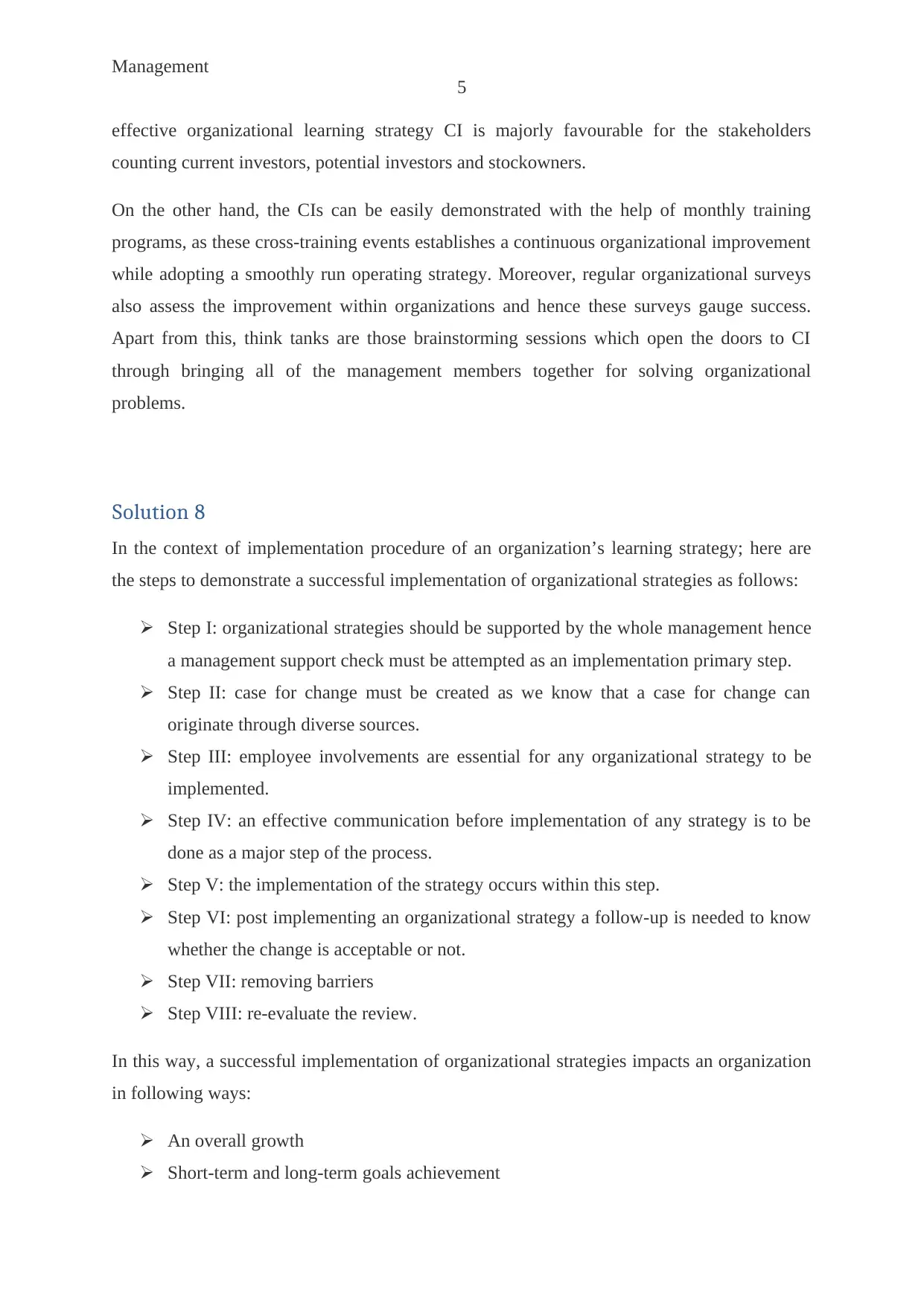
Management
5
effective organizational learning strategy CI is majorly favourable for the stakeholders
counting current investors, potential investors and stockowners.
On the other hand, the CIs can be easily demonstrated with the help of monthly training
programs, as these cross-training events establishes a continuous organizational improvement
while adopting a smoothly run operating strategy. Moreover, regular organizational surveys
also assess the improvement within organizations and hence these surveys gauge success.
Apart from this, think tanks are those brainstorming sessions which open the doors to CI
through bringing all of the management members together for solving organizational
problems.
Solution 8
In the context of implementation procedure of an organization’s learning strategy; here are
the steps to demonstrate a successful implementation of organizational strategies as follows:
Step I: organizational strategies should be supported by the whole management hence
a management support check must be attempted as an implementation primary step.
Step II: case for change must be created as we know that a case for change can
originate through diverse sources.
Step III: employee involvements are essential for any organizational strategy to be
implemented.
Step IV: an effective communication before implementation of any strategy is to be
done as a major step of the process.
Step V: the implementation of the strategy occurs within this step.
Step VI: post implementing an organizational strategy a follow-up is needed to know
whether the change is acceptable or not.
Step VII: removing barriers
Step VIII: re-evaluate the review.
In this way, a successful implementation of organizational strategies impacts an organization
in following ways:
An overall growth
Short-term and long-term goals achievement
5
effective organizational learning strategy CI is majorly favourable for the stakeholders
counting current investors, potential investors and stockowners.
On the other hand, the CIs can be easily demonstrated with the help of monthly training
programs, as these cross-training events establishes a continuous organizational improvement
while adopting a smoothly run operating strategy. Moreover, regular organizational surveys
also assess the improvement within organizations and hence these surveys gauge success.
Apart from this, think tanks are those brainstorming sessions which open the doors to CI
through bringing all of the management members together for solving organizational
problems.
Solution 8
In the context of implementation procedure of an organization’s learning strategy; here are
the steps to demonstrate a successful implementation of organizational strategies as follows:
Step I: organizational strategies should be supported by the whole management hence
a management support check must be attempted as an implementation primary step.
Step II: case for change must be created as we know that a case for change can
originate through diverse sources.
Step III: employee involvements are essential for any organizational strategy to be
implemented.
Step IV: an effective communication before implementation of any strategy is to be
done as a major step of the process.
Step V: the implementation of the strategy occurs within this step.
Step VI: post implementing an organizational strategy a follow-up is needed to know
whether the change is acceptable or not.
Step VII: removing barriers
Step VIII: re-evaluate the review.
In this way, a successful implementation of organizational strategies impacts an organization
in following ways:
An overall growth
Short-term and long-term goals achievement
⊘ This is a preview!⊘
Do you want full access?
Subscribe today to unlock all pages.

Trusted by 1+ million students worldwide
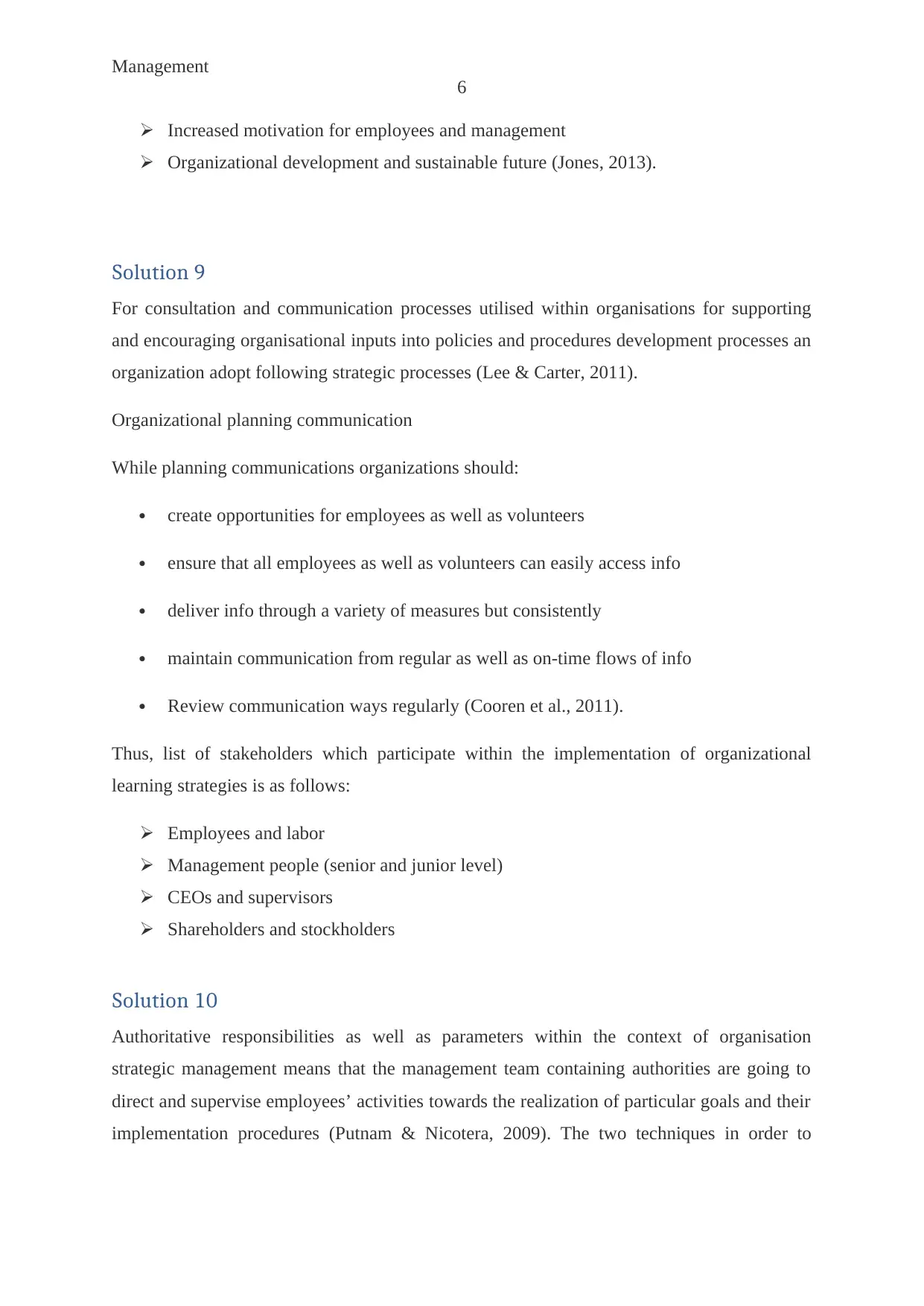
Management
6
Increased motivation for employees and management
Organizational development and sustainable future (Jones, 2013).
Solution 9
For consultation and communication processes utilised within organisations for supporting
and encouraging organisational inputs into policies and procedures development processes an
organization adopt following strategic processes (Lee & Carter, 2011).
Organizational planning communication
While planning communications organizations should:
create opportunities for employees as well as volunteers
ensure that all employees as well as volunteers can easily access info
deliver info through a variety of measures but consistently
maintain communication from regular as well as on-time flows of info
Review communication ways regularly (Cooren et al., 2011).
Thus, list of stakeholders which participate within the implementation of organizational
learning strategies is as follows:
Employees and labor
Management people (senior and junior level)
CEOs and supervisors
Shareholders and stockholders
Solution 10
Authoritative responsibilities as well as parameters within the context of organisation
strategic management means that the management team containing authorities are going to
direct and supervise employees’ activities towards the realization of particular goals and their
implementation procedures (Putnam & Nicotera, 2009). The two techniques in order to
6
Increased motivation for employees and management
Organizational development and sustainable future (Jones, 2013).
Solution 9
For consultation and communication processes utilised within organisations for supporting
and encouraging organisational inputs into policies and procedures development processes an
organization adopt following strategic processes (Lee & Carter, 2011).
Organizational planning communication
While planning communications organizations should:
create opportunities for employees as well as volunteers
ensure that all employees as well as volunteers can easily access info
deliver info through a variety of measures but consistently
maintain communication from regular as well as on-time flows of info
Review communication ways regularly (Cooren et al., 2011).
Thus, list of stakeholders which participate within the implementation of organizational
learning strategies is as follows:
Employees and labor
Management people (senior and junior level)
CEOs and supervisors
Shareholders and stockholders
Solution 10
Authoritative responsibilities as well as parameters within the context of organisation
strategic management means that the management team containing authorities are going to
direct and supervise employees’ activities towards the realization of particular goals and their
implementation procedures (Putnam & Nicotera, 2009). The two techniques in order to
Paraphrase This Document
Need a fresh take? Get an instant paraphrase of this document with our AI Paraphraser

Management
7
communicate with the company’s customers in the context of marketing activities are as
follows:
Technique 1: conduct a market research as it is an important portion of the process of
growing efficient marketing communication techniques.
Technique 2: participate into social networking web-sites those go one step beyond
the own website through introducing an added accessibility for customers (Sherman,
2018).
Solution 11
The two contemporary approaches for assessing instrument as well as strategy design are as
follows:
1. Utilise assessments being sources of info for organizational development
2. Strictly follow those assessments while using high-quality corrective instructions
(Tagbotor et al., 2015).
The office equipment as well as resources needed to use while implementing marketing
activities are as follows:
Digital software and media
LAN and WAN
E-Learning management system tools
Budget and monetary support (Cooren et al., 2011).
Solution 12
Complying with quality management standards suggests following requirements as follows:
Learn about Quality Management System
Learn why QMS is important for all organisations who want to success
Learn the profits of implementation of a QMS
7
communicate with the company’s customers in the context of marketing activities are as
follows:
Technique 1: conduct a market research as it is an important portion of the process of
growing efficient marketing communication techniques.
Technique 2: participate into social networking web-sites those go one step beyond
the own website through introducing an added accessibility for customers (Sherman,
2018).
Solution 11
The two contemporary approaches for assessing instrument as well as strategy design are as
follows:
1. Utilise assessments being sources of info for organizational development
2. Strictly follow those assessments while using high-quality corrective instructions
(Tagbotor et al., 2015).
The office equipment as well as resources needed to use while implementing marketing
activities are as follows:
Digital software and media
LAN and WAN
E-Learning management system tools
Budget and monetary support (Cooren et al., 2011).
Solution 12
Complying with quality management standards suggests following requirements as follows:
Learn about Quality Management System
Learn why QMS is important for all organisations who want to success
Learn the profits of implementation of a QMS
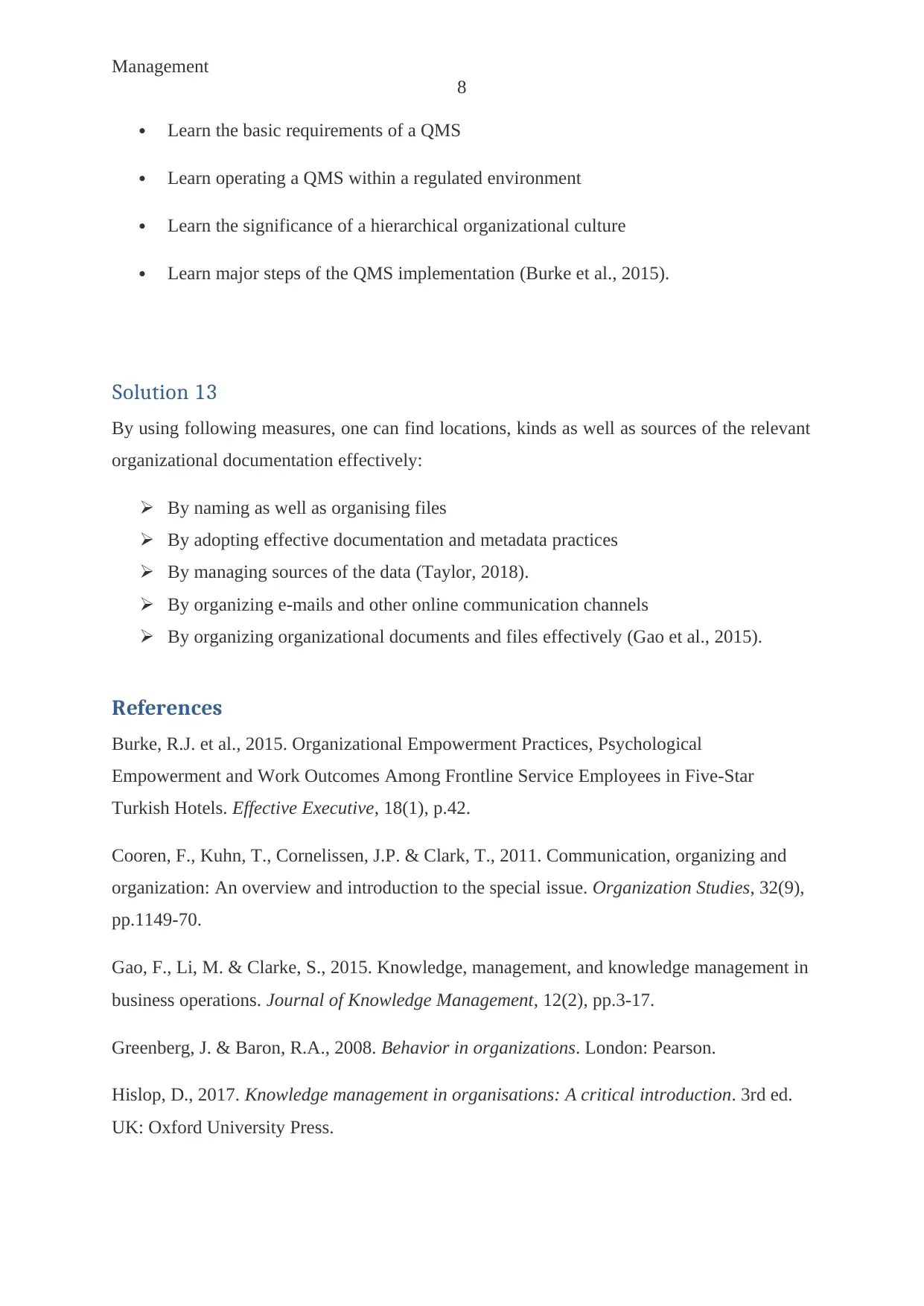
Management
8
Learn the basic requirements of a QMS
Learn operating a QMS within a regulated environment
Learn the significance of a hierarchical organizational culture
Learn major steps of the QMS implementation (Burke et al., 2015).
Solution 13
By using following measures, one can find locations, kinds as well as sources of the relevant
organizational documentation effectively:
By naming as well as organising files
By adopting effective documentation and metadata practices
By managing sources of the data (Taylor, 2018).
By organizing e-mails and other online communication channels
By organizing organizational documents and files effectively (Gao et al., 2015).
References
Burke, R.J. et al., 2015. Organizational Empowerment Practices, Psychological
Empowerment and Work Outcomes Among Frontline Service Employees in Five-Star
Turkish Hotels. Effective Executive, 18(1), p.42.
Cooren, F., Kuhn, T., Cornelissen, J.P. & Clark, T., 2011. Communication, organizing and
organization: An overview and introduction to the special issue. Organization Studies, 32(9),
pp.1149-70.
Gao, F., Li, M. & Clarke, S., 2015. Knowledge, management, and knowledge management in
business operations. Journal of Knowledge Management, 12(2), pp.3-17.
Greenberg, J. & Baron, R.A., 2008. Behavior in organizations. London: Pearson.
Hislop, D., 2017. Knowledge management in organisations: A critical introduction. 3rd ed.
UK: Oxford University Press.
8
Learn the basic requirements of a QMS
Learn operating a QMS within a regulated environment
Learn the significance of a hierarchical organizational culture
Learn major steps of the QMS implementation (Burke et al., 2015).
Solution 13
By using following measures, one can find locations, kinds as well as sources of the relevant
organizational documentation effectively:
By naming as well as organising files
By adopting effective documentation and metadata practices
By managing sources of the data (Taylor, 2018).
By organizing e-mails and other online communication channels
By organizing organizational documents and files effectively (Gao et al., 2015).
References
Burke, R.J. et al., 2015. Organizational Empowerment Practices, Psychological
Empowerment and Work Outcomes Among Frontline Service Employees in Five-Star
Turkish Hotels. Effective Executive, 18(1), p.42.
Cooren, F., Kuhn, T., Cornelissen, J.P. & Clark, T., 2011. Communication, organizing and
organization: An overview and introduction to the special issue. Organization Studies, 32(9),
pp.1149-70.
Gao, F., Li, M. & Clarke, S., 2015. Knowledge, management, and knowledge management in
business operations. Journal of Knowledge Management, 12(2), pp.3-17.
Greenberg, J. & Baron, R.A., 2008. Behavior in organizations. London: Pearson.
Hislop, D., 2017. Knowledge management in organisations: A critical introduction. 3rd ed.
UK: Oxford University Press.
⊘ This is a preview!⊘
Do you want full access?
Subscribe today to unlock all pages.

Trusted by 1+ million students worldwide
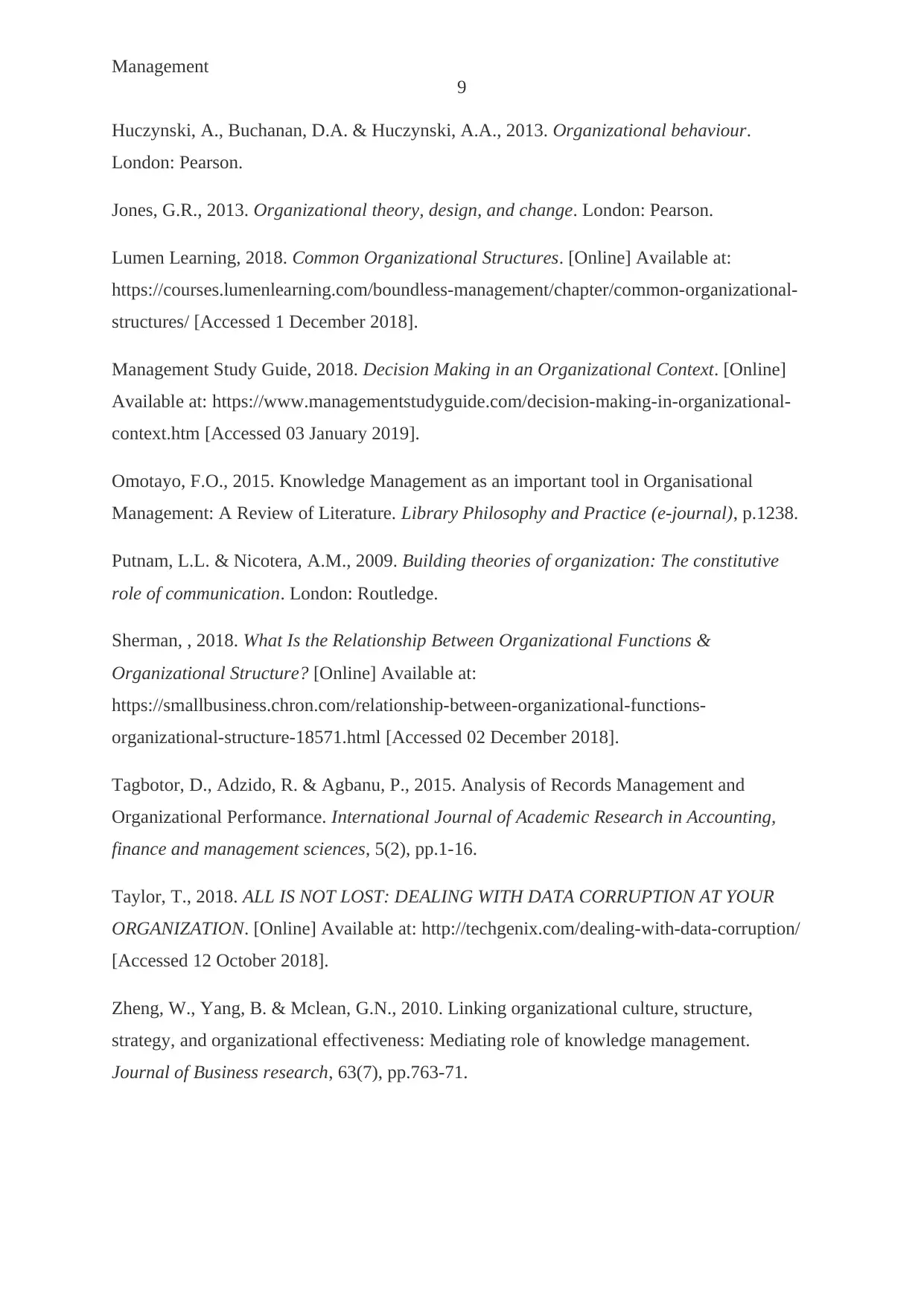
Management
9
Huczynski, A., Buchanan, D.A. & Huczynski, A.A., 2013. Organizational behaviour.
London: Pearson.
Jones, G.R., 2013. Organizational theory, design, and change. London: Pearson.
Lumen Learning, 2018. Common Organizational Structures. [Online] Available at:
https://courses.lumenlearning.com/boundless-management/chapter/common-organizational-
structures/ [Accessed 1 December 2018].
Management Study Guide, 2018. Decision Making in an Organizational Context. [Online]
Available at: https://www.managementstudyguide.com/decision-making-in-organizational-
context.htm [Accessed 03 January 2019].
Omotayo, F.O., 2015. Knowledge Management as an important tool in Organisational
Management: A Review of Literature. Library Philosophy and Practice (e-journal), p.1238.
Putnam, L.L. & Nicotera, A.M., 2009. Building theories of organization: The constitutive
role of communication. London: Routledge.
Sherman, , 2018. What Is the Relationship Between Organizational Functions &
Organizational Structure? [Online] Available at:
https://smallbusiness.chron.com/relationship-between-organizational-functions-
organizational-structure-18571.html [Accessed 02 December 2018].
Tagbotor, D., Adzido, R. & Agbanu, P., 2015. Analysis of Records Management and
Organizational Performance. International Journal of Academic Research in Accounting,
finance and management sciences, 5(2), pp.1-16.
Taylor, T., 2018. ALL IS NOT LOST: DEALING WITH DATA CORRUPTION AT YOUR
ORGANIZATION. [Online] Available at: http://techgenix.com/dealing-with-data-corruption/
[Accessed 12 October 2018].
Zheng, W., Yang, B. & Mclean, G.N., 2010. Linking organizational culture, structure,
strategy, and organizational effectiveness: Mediating role of knowledge management.
Journal of Business research, 63(7), pp.763-71.
9
Huczynski, A., Buchanan, D.A. & Huczynski, A.A., 2013. Organizational behaviour.
London: Pearson.
Jones, G.R., 2013. Organizational theory, design, and change. London: Pearson.
Lumen Learning, 2018. Common Organizational Structures. [Online] Available at:
https://courses.lumenlearning.com/boundless-management/chapter/common-organizational-
structures/ [Accessed 1 December 2018].
Management Study Guide, 2018. Decision Making in an Organizational Context. [Online]
Available at: https://www.managementstudyguide.com/decision-making-in-organizational-
context.htm [Accessed 03 January 2019].
Omotayo, F.O., 2015. Knowledge Management as an important tool in Organisational
Management: A Review of Literature. Library Philosophy and Practice (e-journal), p.1238.
Putnam, L.L. & Nicotera, A.M., 2009. Building theories of organization: The constitutive
role of communication. London: Routledge.
Sherman, , 2018. What Is the Relationship Between Organizational Functions &
Organizational Structure? [Online] Available at:
https://smallbusiness.chron.com/relationship-between-organizational-functions-
organizational-structure-18571.html [Accessed 02 December 2018].
Tagbotor, D., Adzido, R. & Agbanu, P., 2015. Analysis of Records Management and
Organizational Performance. International Journal of Academic Research in Accounting,
finance and management sciences, 5(2), pp.1-16.
Taylor, T., 2018. ALL IS NOT LOST: DEALING WITH DATA CORRUPTION AT YOUR
ORGANIZATION. [Online] Available at: http://techgenix.com/dealing-with-data-corruption/
[Accessed 12 October 2018].
Zheng, W., Yang, B. & Mclean, G.N., 2010. Linking organizational culture, structure,
strategy, and organizational effectiveness: Mediating role of knowledge management.
Journal of Business research, 63(7), pp.763-71.
Paraphrase This Document
Need a fresh take? Get an instant paraphrase of this document with our AI Paraphraser

Management
10
10
1 out of 11
Related Documents
Your All-in-One AI-Powered Toolkit for Academic Success.
+13062052269
info@desklib.com
Available 24*7 on WhatsApp / Email
![[object Object]](/_next/static/media/star-bottom.7253800d.svg)
Unlock your academic potential
Copyright © 2020–2025 A2Z Services. All Rights Reserved. Developed and managed by ZUCOL.




